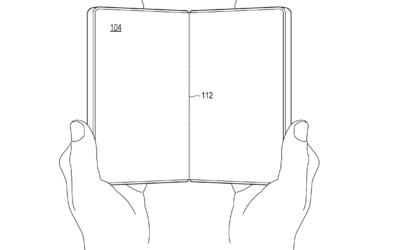Microsoft is reportedly exploring a new approach to foldable phone technology, signaling a potential return to the smartphone market after the discontinuation of its Surface Duo line. A recently unveiled patent application suggests the tech giant is developing a device with a unique hinge mechanism aimed at improving durability and minimizing the dreaded crease.

The patent application, filed with the United States Patent and Trademark Office on February 29, details a foldable smartphone concept featuring a "spine cover plate." This innovative design seeks to address some of the key challenges facing current foldable devices.
The application suggests a book-style design, reminiscent of the Samsung Galaxy Z Fold series, incorporating a flexible display. However, the core focus is the spine cover plate, designed to shield the single-hinge system and enhance its structural integrity.
The key differentiating factor lies in the spine cover's ability to automatically adjust during opening and closing. This is intended to eliminate unnecessary gaps around the hinge, providing enhanced protection against dust and water intrusion. Current foldable designs, like Samsung's, offer IPX8 water resistance, but Microsoft's approach aims for even greater durability.
The patent indicates that this new hinge mechanism could significantly reduce, or even eliminate, the visibility of the hinge crease – a common complaint among foldable phone users.
Furthermore, Microsoft's design incorporates techniques to reduce the overall thickness of the device. The spine cover plate retracts towards the central spine when folded, enabling a slimmer and more comfortable grip.
"By retracting the spine cover plate toward the central spine as the first display-supporting frame and the second display-supporting frame are rotated into a face-to-face orientation, the width of the folded computing device is reduced, thereby enabling easier and more comfortable handling of the device, such as with one hand," the patent states.
The smartphone industry is constantly seeking ways to minimize or eliminate the crease in foldable displays. While some manufacturers have adopted water-drop folding mechanisms with limited success, a truly crease-free solution remains elusive. Durability is another critical factor, given the numerous moving parts in foldable devices.
The addition of another layer, or movable part, in the form of the spine cover plate raises questions about its practicality. Despite the potential benefits and enhanced durability outlined in the patent application, the complexity of the design could introduce new challenges.
Newer articles
Older articles
 Esha Gupta Sets Record Straight: Actress Addresses Hardik Pandya Dating Rumors
Esha Gupta Sets Record Straight: Actress Addresses Hardik Pandya Dating Rumors
 Google Maps to Boost Navigation Accuracy with Fused Orientation Provider API
Google Maps to Boost Navigation Accuracy with Fused Orientation Provider API
 Global Vaccination Rates Plunge: Millions of Children Now Vulnerable to Preventable Diseases
Global Vaccination Rates Plunge: Millions of Children Now Vulnerable to Preventable Diseases
 Rishabh Pant: Greg Chappell Hails India Star as Cricket Revolutionary
Rishabh Pant: Greg Chappell Hails India Star as Cricket Revolutionary
 Skin Cancer Alert: How to Identify Suspicious Moles and Early Warning Signs
Skin Cancer Alert: How to Identify Suspicious Moles and Early Warning Signs
 Gavaskar Calls for Kuldeep Yadav's Inclusion in Second Test Amid Bumrah Fitness Concerns
Gavaskar Calls for Kuldeep Yadav's Inclusion in Second Test Amid Bumrah Fitness Concerns
 Is Daily Pooping a Must? Understanding Bowel Regularity and When to Worry
Is Daily Pooping a Must? Understanding Bowel Regularity and When to Worry
 Suryakumar Yadav's Sports Hernia: Understanding the Injury, Recovery, and Risk Factors for Athletes
Suryakumar Yadav's Sports Hernia: Understanding the Injury, Recovery, and Risk Factors for Athletes
 Vijay Sethupathi Apologizes Amid Controversy Over Son Surya's Debut Film 'Phoenix' and Alleged Video Removal Pressure
Vijay Sethupathi Apologizes Amid Controversy Over Son Surya's Debut Film 'Phoenix' and Alleged Video Removal Pressure
 Install Baccarat Hack Tool: The Secret to Winning
Install Baccarat Hack Tool: The Secret to Winning